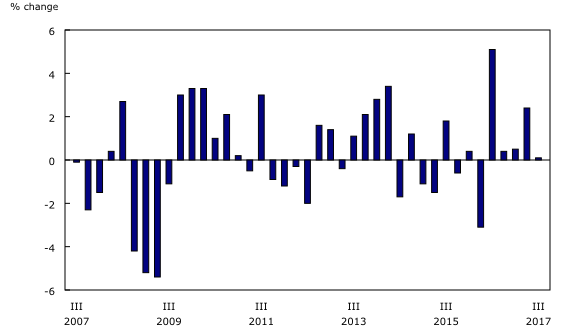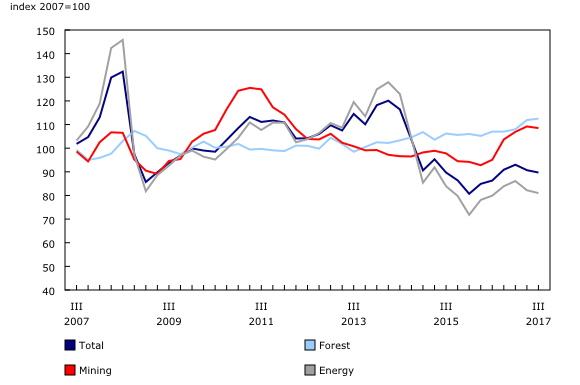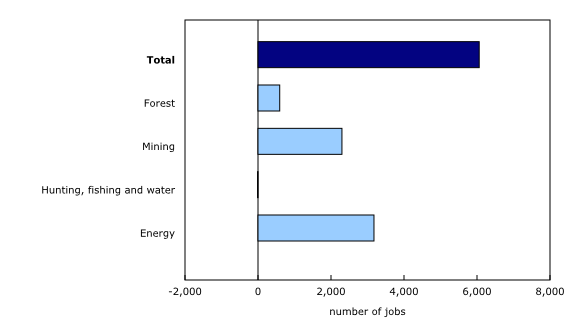Natural resource indicators, third quarter 2017
Archived Content
Information identified as archived is provided for reference, research or recordkeeping purposes. It is not subject to the Government of Canada Web Standards and has not been altered or updated since it was archived. Please "contact us" to request a format other than those available.
Released: 2018-01-18
The volume of natural resource production edges up
Real natural resource gross domestic product (GDP), or the volume of economic activity attributable to natural resources, edged up 0.1% in the third quarter, following growth of 2.4% in the second quarter. In comparison, GDP for the total economy grew 0.6% in the third quarter.
Energy (-0.2%), the largest subsector, saw a slight decline with negative or zero growth across most product groupings. Electricity (+4.0%) was the lone commodity group showing growth in this subsector. The forest subsector (-1.2%) also saw a decrease. Both of these subsectors were affected by wildfires during the quarter, temporarily suspending production at some locations. This was also the first full quarter where US softwood lumber tariffs were in effect.
Minerals and mining (+1.8%) was the lone subsector that increased in the third quarter. This growth was driven primarily by non-metallic mineral extraction (+9.7%), coinciding with the opening of the Bethune potash mine in Saskatchewan.
Natural resource activity totalled $211 billion (nominal terms, at annual rates) in the third quarter, accounting for 10.6% of Canada's GDP.
Natural resource prices fall
Natural resource prices fell 1.1% in the third quarter, with price decreases in the energy subsector (-1.5%) as the primary driver. The decline was concentrated in a few commodity groups, with crude oil extraction (-5.8%) as the largest contributor. Prices in the mining and minerals subsector (-0.6%) were also down.
Prices were up in the forest subsector (+0.6%), with the largest price increase occurring for primary wood and sawmill products (+2.1%). Despite a decline in the last two quarters, natural resource prices remained 3.9% higher than for the same quarter the previous year.
Export and import volumes down
Real natural resource exports decreased 2.0% in the third quarter following an increase of 3.5% in the second quarter. Energy exports fell 2.2% due to a decline in natural gas exports of 8.0%. Minerals and mining exports fell 1.6%, while exports in the forest subsector fell 1.8%, with the decline concentrated in sawmill and lumber products.
Real natural resource imports decreased 2.6% in the third quarter. The energy subsector drove the decrease (-3.0%), with imports of crude oil down 14.0%.
Employment increases in the third quarter
Jobs in the natural resources sector increased by 1.0% in the third quarter, with most subsectors seeing growth. This was led by the energy subsector, which grew by 3,200 jobs (+1.2%). These job gains continued from the second quarter, where 6,800 jobs were added in the subsector.
The minerals and mining subsector added 2,300 jobs (+1.1%) in the third quarter, while forestry added 600 jobs (+0.5%). In comparison, the number of jobs across all industries grew 0.6% in the third quarter.
Downstream activities decrease
Secondary and tertiary processing for the forest and minerals and mining subsectors are identified in the natural resource indicators for analytical purposes. An additional 1.6% of Canadian GDP is attributable to these downstream activities.
Real GDP of these additional downstream activities increased 0.5% in the third quarter.
Note to readers
The natural resource indicators provide quarterly indicators for the main aggregates in the Natural Resource Satellite Account, namely, nominal and real gross domestic product, output, real exports and imports, and employment. The estimates from this account are directly comparable to the estimates found in the Canadian System of Macroeconomic Accounts.
The energy subsector accounts for approximately two-thirds of the Canadian natural resource sector, while the mining subsector accounts for just over 20%. The forest (8%) and hunting, fishing and water (4%) subsectors account for the rest.
Next release
Data on natural resource indicators for the fourth quarter of 2017 will be released on March 27, 2018.
Products
Additional information can be found in the articles "The Natural Resources Satellite Account: Feasibility study" and "The Natural Resources Satellite Account – Sources and methods," which are part of the Income and Expenditure Accounts Technical Series (13-604-M).
The Latest Developments in the Canadian Economic Accounts (13-605-X) is available.
The User Guide: Canadian System of Macroeconomic Accounts (13-606-G) is available.
The Methodological Guide: Canadian System of Macroeconomic Accounts (13-607-X) is available.
The System of Macroeconomic Accounts module features an up-to-date portrait of national and provincial economies and their structure.
Contact information
For more information, or to enquire about the concepts, methods or data quality of this release, contact us (toll-free 1-800-263-1136; 514-283-8300; STATCAN.infostats-infostats.STATCAN@canada.ca) or Media Relations (613-951-4636; STATCAN.mediahotline-ligneinfomedias.STATCAN@canada.ca).
- Date modified:





